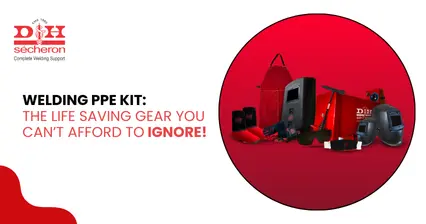Ferritic steel is a commonly used stainless steel in welding. It belongs to the stainless steel family which also includes austenitic, duplex, martensitic and precipitation hardening steels. It is a type of stainless steel alloy and contains more than 12% chromium. The proportion of chromium may go up to 30%. However, the carbon content is less than 0.10%. It may or may not have nickel.
Ferritic steel is available in different grades, depending on ferritic stainless steel composition. It can be classified into 1 to 5 grades as per the American Iron and Steel Institute (AISI). The grades 1 to 3 are referred to as standard grades while the grades 4 and 5 are referred to as speciality grades because they are used only in special cases.
The ferritic materials have a wide range of applications in the following industries:
-
Industrial equipment
-
Kitchenware
-
Coldwater tanks
-
Chemical and food processing
-
Electrical cabinets
-
Water treatment plan
-
Automotive production
-
Induction cookers
-
Magnetic fasteners
-
Dishwashers
-
Kitchen sinks
-
Coins
-
Nuclear reactors
-
Heat transfer applications
Development of Ferritic Stainless Steels
The history of ferritic steel can be traced to 1912 when Canada-born engineer Frederick Mark Becket discovered a ferrous alloy containing 25-27% chromium. It was the first high-chromium alloy which became heat-resisting stainless steel. However, it was not until the 1980s that ferritic steel became commercially popular.
Ferritic Stainless Steel Properties
The characteristic of ferritic steel is defined by its Body-Centred Cubic (BCC) crystal structure. This means that the crystal structure has a cubic atom cell with an atom in the centre. It is similar to pure iron at room temperature. It is also made up of microstructures called ferrite. Ferrite is a ceramic compound which is a mixture of iron oxide and one or more other metals with ferrimagnetic properties.
Ferritic steel has the following properties:
-
Magnetic
-
Non-hardenable by heat treatment
-
Slightly hardenable by cold rolling
-
Corrosion-resistant
-
Good ductility and formability
-
Low coefficient of thermal expansion
-
High thermal conductivity
-
High oxidation resistance
Weldability of Ferritic Steel
Though ferritic steel has low weldability, it is suitable for most arc welding processes. When it comes to Shielded Metal Arc Welding - SMAW electrodes, ferritic steel can offer superior performance. However, welders should limit the heat input to minimise grain growth which otherwise could result in joint cracking.
Conventional Welding
It refers to the process of joining ferritic metal through the application of heat with or without applying pressure or filter.
Reclamation Welding
It refers to the repair of a badly worn out component of ferritic metal and bringing it to its original condition.
If you are looking for flux or wires to weld ferritic steel, you can consider buying them from D&H Secheron.
11 May 2025 | Welding
An In-Depth Exploration of Low-Alloy Steel: Your Comprehensive Guide
11 May 2025 | Welding
Nagpur - Bori - Tuljapur Road MSH-3 in Yavatmal District (Maharashtra)
11 May 2025 | Welding
Guidelines to Understand Gas Welding: Applications, Advantages & Disadvantages
11 May 2025 | Welding
3 Tips for Finding the Best Mild Steel Electrode for Your Application
11 May 2025 | Welding
How to Select the Right Welding Filler Wires for Stainless Steel Welding?
11 May 2025 | Welding
Building the Narendra Modi Stadium with Norma V and Autotherme-1 Electrodes
11 May 2025 | Welding
Low Alloy Steel Welding in a (PEB) Pre Engineered Building Structure
11 May 2025 | Welding
Welding Rods: Different Types and Tips for Properly Storing and Handling
11 May 2025 | Welding
Tips for Flawless Welds with Stainless Steel Electrodes: Pros and Cons
11 May 2025 | Welding
Exploring Applications and Benefits of Stainless Steel Welding Electrodes
11 May 2025 | Welding
Welding Basics: Joining Metals with Heat and Pressure - A Beginners Guide
11 May 2025 | Welding
Distinguishing Low-Alloy Steel from High-Alloy Steel: Understanding the Variations
11 May 2025 | Welding
Hard Facing Wire - Understanding the Process and Achieving Optimal Result
11 May 2025 | Welding
Exploring the Advantages of Stainless Steel Electrodes in Welding Applications
11 May 2025 | Welding
Weathering Steel vs. Traditional Steel: A Comparative Analysis of Performance
11 May 2025 | Welding
Choosing the Right Welding Rod: Why 6013 Electrodes Might Be Your Ideal Option
11 May 2025 | Welding
Why 7018 Electrodes Are Preferred for High-Strength Welds in Pipeline Construction
11 May 2025 | Welding
Filler Wire vs. Stainless Steel Filler Wire: Understanding the Key Differences
11 May 2025 | Welding
Exploring the Impact of Filler Material on Welding Quality and Durability
11 May 2025 | Welding
Choosing the Right Cast Iron Electrode for Different Welding Projects
11 May 2025 | Welding
Top Advantages of Cast Iron Electrodes for Industrial Welding Applications
11 May 2025 | Welding
Key Benefits and Challenges of Using TIG Welding in Industrial Projects
11 May 2025 | Welding
5 Reasons Why 7018 Electrode is the Gold Standard for Welding Professionals
11 May 2025 | Welding
Top 5 Advantages of Flux Cored Arc Welding for Heavy-Duty Applications.png)
11 May 2025 | Welding
Lotherme-601: A Game-Changer for Restoring Shoulder Pins in Heavy Machinery
11 May 2025 | Welding
How D&H Sécheron Helped Repair a Rotary Kiln’s Cooler Section with LoTherme 352
11 May 2025 | Welding
Piston Repair for Mining Industry: Cost-Effective Solutions with LoTherme 468.webp)






.jpg)







































.jpg)
.jpg)

.jpg)

.jpg)





.jpg)
.jpg)
.jpg)



.webp)
.jpg)
.jpg)
.webp)
.jpg)






















.png)



.webp)

.webp)
.webp)



